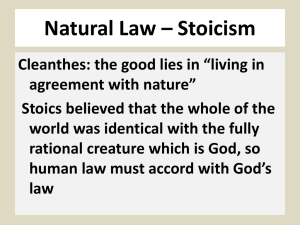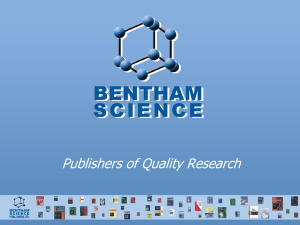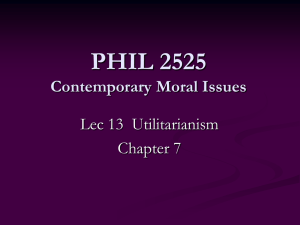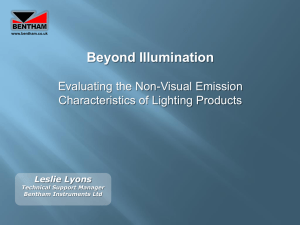A Guide to Spectroradiometry
advertisement
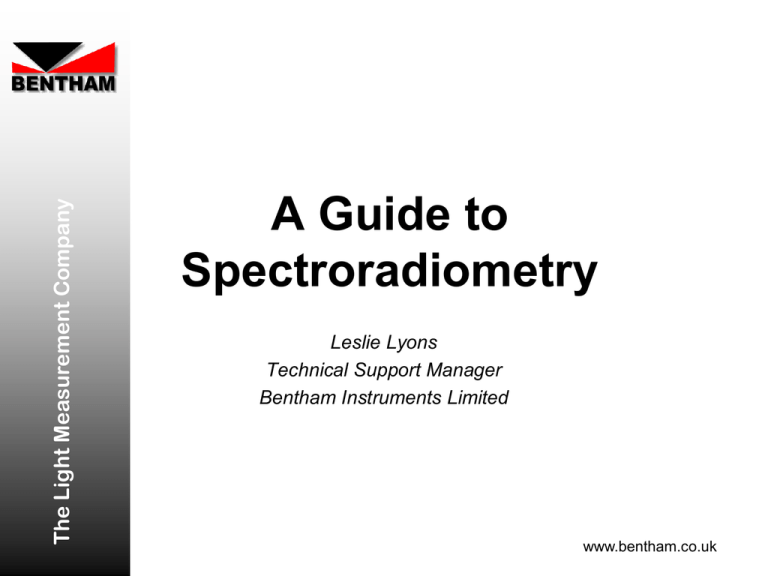
The Light Measurement Company A Guide to Spectroradiometry Leslie Lyons Technical Support Manager Bentham Instruments Limited www.bentham.co.uk Bentham Instruments Ltd The Light Measurement Company Bentham Instruments offers over 30 years extensive experience in the manufacture and supply of standard instruments and custom systems for applications involving the study and measurement of light. Our established customer base includes many blue chip organisations , highly respected university research departments, National Metrology Institutes worldwide, etc. We pride ourselves on supplying them with reliable and accurate instrumentation. Established: 1975 Employees: 15 Privately owned (GBP 1.75M shareholders funds available) www.bentham.co.uk The Nature of Light •Electromagnetic radiation •Light exists as photons displaying both wave and particle properties •Discrete quanta of energy Monochromator Operation •Energy inversely proportional to wavelength •Measurements in 200nm-50µm range of EM spectrum www.bentham.co.uk Broadband Emission •Light emitted from sources combination of finite number of wavelengths •Require to determine spectrum of source, component at each wavelength Monochromator Operation •Disperse- separate component wavelengths www.bentham.co.uk The Dispersion of Light Monochromator•Low throughput Monochromator Operation •High spectral resolution Filter based•High throughput •Low spectral resolution Prism•Limited spectral range •Non-linear dispersion www.bentham.co.uk Czerny- Turner Configuration •Light input at entrance slit at distance f from concave mirror Entrance Slit Monochromator Operation •Light collimated by concave mirror, focal length, f Collimator •Reflection grating disperses light •Second concave mirror refocuses light onto exit slit Re-focus Exit Slit •Rotate grating to select another wavelength www.bentham.co.uk Diffraction Gratings •Diffraction grating consists of thousands of etched terraces (~1000/mm) •Each terrace reflects incident light; interference of light from adjacent terraces Monochromator Operation •Rotate grating to select wavelength •Ruled gratings produced by mechanical means; high efficiency but potentially high stray light component •Holographic gratings produced by holographic exposure of photoresist followed by chemical etch; lower efficiency, low stray light www.bentham.co.uk Order Sorting •“Two- rainbow effect” •Grating equation nλ =dsinθ Monochromator Operation •n, diffraction order •Wish to measure only 1st order •Suppress higher orders (lower wavelengths) •Insert long pass filters www.bentham.co.uk Bandwidth •Imaging optical system •Entrance port imaged at exit in infinity of monochromatic images Monochromator Operation •Plane of exit port wavelength axis •System bandwidth defined by largest aperture •Bandwidth determined as FWHM of line source •Impact on spectral resolution •Impact upon system throughput Diffraction Grating Line Density (g/mm) Dispersion in TMc300 (nm/mm) Recommended Spectral Range of Use (nm) 2400 1.35 200-600 1800 1.8 250-800 1200 2.7 300-1200 600 5.4 1000-2500 •Varies with grating line density www.bentham.co.uk Slit Function •Provides information on “near field” scatter Monochromator Operation •Measurement of line source •Consideration of system response away from selected wavelength •For sources with sharp changes, may be of import www.bentham.co.uk Stray Light •White light to be measured input to monochromator Entrance Slit Collimator Monochromator Operation •Some white light reflected off the beaten track- mirror mounts etc. •At exit port is presented selected wavelength and some white “stray” light •Where signal to be measured smaller than stray light problem shall be seen Re-focus Exit Slit www.bentham.co.uk Double Monochromator Monochromator Operation •Pass output of first monochromator through second device •Re-disperse selected wavelength and stray light component •Re-select desired wavelength •Stray light performance effectively squared •Triple monochromator for extreme instances (eg. Raman) www.bentham.co.uk Definitions Spectroradiometer An instrument for measurement of radiometric quantities in narrow wavelength intervals over a given spectral region (CIE) Monochromator Applications e.g. irradiance, radiance, etc Spectrophotometer An instrument for measurement of the ratio of two values of a radiometric quantity at the same wavelength (CIE) e.g. transmission, reflection, absorption Spectrometer More generic, incorporates wavelength dispersion, spectral features e.g. as above, AA, OES, LIBS, fluorimeters, Raman etc. www.bentham.co.uk Spectroradiometer Measurement Quantities Typical input optic Diffuser Measurement Quantity Unit Photometric Parameter Photometric Unit Spectral irradiance mW/(m2.nm) Illuminance lux Spectral radiance mW/(sr.m2.nm) Luminance cd/m2 Spectral radiant intensity mW/(sr.nm) Luminous intensity cd Spectral total radiant flux mW/nm Total luminous flux lumens Spectroradiometry Telescope Baffled Tube Integrating Sphere www.bentham.co.uk14 Spectral Irradiance ) E ( ) A •Power arriving at a surface from entire hemisphere above •Irradiance reduces with cosine of incident angle Φ relation for point sources θ •Input optic cosine response, 2π field of view Comparison cosine response d5, d6 difuser- deviation from true cosine reponse 30 •Calibrate against standard of irradiance at given distance d6 f2=0.84% at 400nm 20 Deviation from true cosine response (%) Spectroradiometry •1/r2 A/cosθ A •Irradiance reduces with increasing distance d5= 9.3% at 400nm 10 0 -85 -65 -45 -25 -5 15 35 55 -10 -20 -30 -40 -50 Angle (°) www.bentham.co.uk 75 Spectral Radiance •Power emitted from a source per unit area into unit solid angle •Radiance is not dependant on distance •Sometimes termed brightness •Quantity measured of displays ) L( ) A. Spectroradiometry •Measured using imaging technique •Source must overfill field of view to measure absolute radiance •Calibrate against standard of spectra radiance www.bentham.co.uk Field of View •Image source onto measurement plane •Select appropriate aperture at measurement plane •For non-uniform sources, image brightest part •In certain instances, field of view is larger than sourcemeasure therefore average radiance over FOV Spectroradiometry Aperture stop, D d, aperture (field stop) α eff α eff Solid angle, Ω distance, h Image Object distance, H www.bentham.co.uk Spectral Radiant Intensity •Power emitted from a source into unit solid angle •Quantity measured of point source signals •Sometimes termed brightness Spectroradiometry •Measured using imaging technique with source under-filling field of view (do not sample area) •Measured as an irradiance, multiplied by distance squared ) L( ) I( ) E( ).r 2 •Calibrated against standard of spectral radiant intensity www.bentham.co.uk Total Spectral Radiant Flux •Total output of lamp •Use integrating sphere to collect all emitted light •Measurement in W nm-1 Spectroradiometry •Calibrate against standard of total spectral radiant flux www.bentham.co.uk Colorimetry Transmission www.bentham.co.uk Total Spectral Radiant Flux Plane diffraction grating Concave mirror Scanning grating One wavelength at exit at time Entrance Slit Collimator Re-focus Spectrophotometry Exit Slit www.bentham.co.uk


